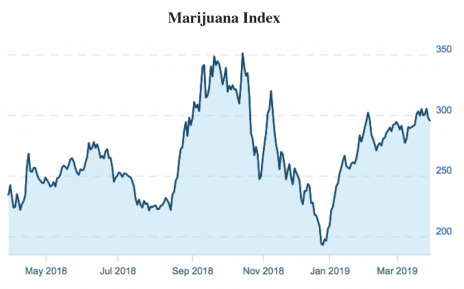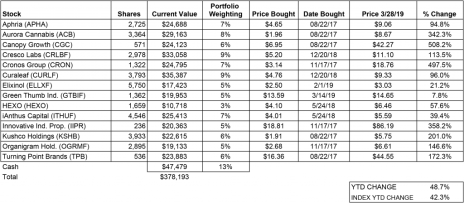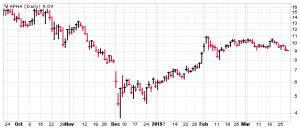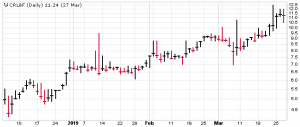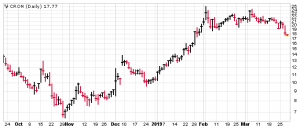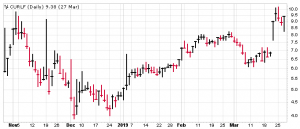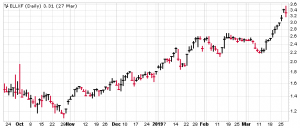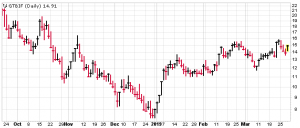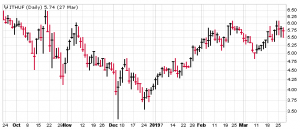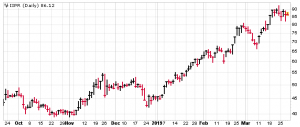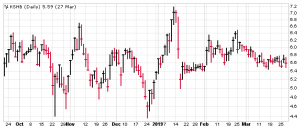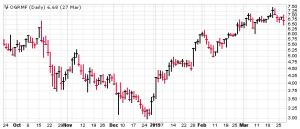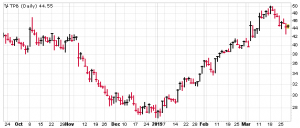CBD is hot, and acquisitions in the cannabis industry seem to occur daily, but the biggest marijuana stocks are cooling, at least for a while.
Long-term, however, I remain very bullish on both the companies and the stocks in the industry and am truly enjoying staying on top of the developments.
The gains so far this year, in both the sector and the portfolio, remain spectacular, but they won’t continue; I guarantee that corrections and volatility will come. And I also guarantee I’ll give you my best ideas on how to deal with them.
Cabot Marijuana Investor 319
CBD Stocks Soar
I take a dose of CBD twice a day. I think it works. I sleep better and have less discomfort in my finger joints—early signs of arthritis. But I’m not sure that it’s working, because there have been no major medical studies on CBD (cannabidiol) yet. Maybe it’s just the placebo effect.
I’m not the only one self-medicating with CBD ahead of official approval from the medical industry. Millions of Americans are doing the same, motivated both by word of mouth and the endorsements of celebrities like Whoopi Goldberg, Martha Stewart (famous for both interior decorating and insider trading), Morgan Freeman, Oliver Stone, Melissa Etheridge and Michael J. Fox.
And now the CBD stocks are moving as the product becomes available in mainstream chains CVS and Walgreens. The past few weeks have brought good gains from our recent buy Elixinol (ELLXF), as well as CBD competitors CV Sciences (CVSI) and Charlotte’s Web Holdings (CWBHF).
Cronos Sinks
Marijuana stocks, too, have continued to advance, particularly lesser-known stocks like the ones that I’ve been highlighting lately. But three of the most famous, highly-valued stocks, Aphria, Canopy and Cronos, have done nothing since the start of February—and just this week, after releasing a decent fourth quarter report, Cronos was hit with a big wave of selling. There’s a real risk that this is the first leak in the boat that’s been keeping these highly valued stocks afloat. Long-term, they all still have great prospects, but the odds continue to be better in lesser-known stocks.
New Jersey Just Says No
Meanwhile, in New Jersey, lawmakers voted against legalizing marijuana, in effect giving a little present to marijuana businesses in neighboring New York. One insight from this process is that legalization is easier to achieve when it’s pursued by voters than by politicians.
Acquisitions Continue
Merger and acquisition activity remain buoyant in the cannabis sector, as companies strive to get big first, and worry about profits later. It worked for Amazon, and it will work for these companies, too. Interestingly, Amazon is not competing in the cannabis space yet. Guess it’s just a matter of time.
The Power of a NYSE or Nasdaq Listing
Stocks that list on the NYSE and Nasdaq are easier for U.S. investors to buy, whether they’re individuals or institutions. Because of this, there’s more demand for these stocks and thus they tend to be more heavily traded, and also more expensive, on a relative basis. Which means there are still bargains to be found on the less visible exchanges—albeit with the cost of thinner trading and higher volatility. However, not all brokers trade cannabis stocks. Not all brokers trade smaller cannabis stocks. And often, you will find that there are extra fees involved in these trades. So, buyer beware. Before you trade, investigate. If the costs are too high, don’t buy. The situation is very fluid, and all factors of investing in the sector are improving rapidly.
The long-term trend of the sector remains clearly up, but it pays to be more heavily invested when the sector is strong, and to be defensive when the sector is weak. This year, the sector blasted off with the broad market in early January, but has lost power as 2019 as progressed, with the latest surge losing steam not far above the February 4 top. A correction appears likely.
What’s Next?
Most likely is that the break in Cronos is just the start of a correction. I say this not just from the action of the charts and valuation studies, but from Cabot’s general market-timing indicators. We haven’t had any pain all year, and the market needs to dish out some pain and worry to set up the next advance!
Investing Strategy
Long-term investors can ride through corrections; I aim to own some of these industry leaders for five and ten years. But shorter-term traders should think about taking profits in some stocks now (APHA, CGC and CRON in particular if you’re overweighted) and waiting for lower-risk entry points. The portfolio has already taken profits in all three of those stocks and is now a bit underweight so will stand pat. Also, there’s always room for tweaking. Today I would lean toward the more defensive (stodgier, if that word can be used in this industry) stocks in the sector, like IIPR, KSHB, TPB and PYX.
Finally, remember, some of the cardinal guidelines: Diversify among stocks, owning both Canadian and U.S. companies. Diversify your buying and selling over time. And try to buy on corrections.
WHAT TO DO NOW
The portfolio will make one small change, averaging up in Kush Bottles (KSHB) by increasing our position by one-third its current size. (In other words, if you own 100 shares, buy another 33 or thereabouts.) We last sold some KSHB at 5.30 back on August 31, 2018, just as the stock was beginning its six-month basing period, and the proceeds have done well in stronger stocks since then. But we’re now slightly underweight in the stock, and I see not only decent upside, based on the business and the valuation, but also minimal downside should the cannabis sector enter into a serious correction.
CURRENT RECOMMENDATIONS
The portfolio was started with a hypothetical $100,000 on August 22, 2017.
Aphria (APHA)
APHA continues to build a base between 9 and 10, but is at risk of falling off this base if the disease that has infected CRON spreads. Long-term, however, it still has great prospects as one of the major Canadian producers, whose products are totally greenhouse grown. Aphria will announce quarterly results on April 15, before the market opens.
Aurora Cannabis (ACB)
Aurora now has Nelson Peltz on its team as a Strategic Advisor, but the long-term chart says that the stock has the potential to pull back to 7. Last week I suggested lightening up if you were overweighted and I still think that’s good advice.
Canopy Growth (CGC)
The most famous company in the industry is also one of the most overvalued, by my measurements, so not an attractive buy but is a solid hold, as long as your position size is reasonable. As I write, the stock is threatening to fall below support at 42—and if that happens, 26 is possible!
Cresco Labs (CRLBF)
One of the up-and-coming vertically integrated multi-state operators (MSOs) in the U.S., Cresco last week announced the acquisition of VidaCann, one of the largest providers of medical cannabis in Florida, and this week it announced more progress in its effort to be licensed in Michigan. With this license and the Florida acquisition, the company will have 15 production facilities, 21 operational retail dispensaries and licenses to operate a total of 51 retail dispensaries in 11 states—Illinois, Pennsylvania, Ohio, Nevada, California, Arizona, Florida, and Michigan with New York, Maryland and Massachusetts pending regulatory approval. CRLBF is still one of the most thinly traded stocks in the portfolio, but the action of the stock has been impressive, advancing on big volume for five days and then finally rolling over Wednesday to begin a well-deserved correction and consolidation. If you don’t own it, you could buy as this correction comes to an end, possibly as low as 9.5. The stock still looks like a decent value to me.
Cronos Group (CRON)
CRON doubled in January as investors clambered to get into the stock that had snagged Altria as a partner. Through February and March, the stock went nowhere, as demand and supply balanced out—not unusual for a very expensive stock. Then on Wednesday morning, the firm announced its fourth quarter results. Revenues were $5.6 million, up 248% from the year before. Interestingly, the stock did virtually nothing all day. But then an analyst downgraded the stock to sell the next day (which is a rare rating), so Wednesday morning the stock opened down 10%. The base is now broken, and unless this break is healed very quickly, you should expect a longer correction in the stock, as many of the investors who bought over the past two months get out at a loss.
Curaleaf Holdings (CURLF)
Curaleaf announced its fourth quarter results after the close on Wednesday, March 20. Revenue was $32.0 million, up 409% from the year-ago quarter. The company opened seven new dispensaries at a rapid pace in key markets such as Florida and Arizona, bringing its totals to 42 dispensaries, 12 cultivation sites and 11 processing sites in 12 states. It became the first multi-state operator to launch a national CBD product line, Curaleaf Hemp. And biggest of all, it announced a partnership with drugstore chain CVS on a line of CBD products including creams, sprays, roll-ons, lotions and salves in eight states: Alabama, California, Colorado, Illinois, Indiana, Kentucky, Maryland and Tennessee. Commercially, this is terrific news, but it’s also interesting from a legal perspective, because recreational marijuana is legal in California and Colorado, and medical marijuana is legal in Illinois and Maryland, but marijuana has not been made legal for recreational nor medicinal uses in the other four states. And while hemp was fully legalized in the Farm Bill passed last December, CBD was not included but instead was put under the purview of the FDA. The strictest interpretation says that CBD is a medical drug, because it is the key ingredient in GW Pharmaceuticals’ Epidiolex, the first cannabis-based drug to win FDA approval as a treatment for severe forms of childhood epilepsy, and the FDA cannot allow a drug to be added to products without the clinical tests and trials required of drug developers. CVS, apparently, thinks it is safe selling CBD now.
The stock soared following the news and is now working to consolidate that gain between 8 and 10. If you don’t own it, you can try to buy in the low end of that range.
Elixinol (ELLXF)
Elixinol is a CBD company, not a marijuana company, and the stock enjoyed 11 consecutive up days in the CBD buying frenzy, eventually rolling over yesterday. Chart-wise, it seems high, but it still looks undervalued to me, so if you don’t own it, you can nibble, ideally on a pullback under 3.
Green Thumb Industries (GTBIF)
This Chicago-based multi-state operator has 11 manufacturing facilities, licenses for 72 retail locations and operations in 12 states. Fourth quarter results will be released on April 9 after the market close. The stock is neither cheap nor expensive relative to its competitors, but it’s just had a decent pullback, so can be bought here.
HEXO Corp. (HEXO)
HEXO has pulled back normally since reporting excellent fourth quarter results two weeks ago. Revenues of $16.2 million make it the fourth largest earner in the Canadian market. We’re still underweight the stock, and I’ve considered averaging up, but it seems more prudent to wait for a lower-risk opportunity.
iAnthus Capital (ITHUF)
iAnthus is a multi-state-operator with a focus on the heavily populated coasts. When its merger with MPS Bioceuticals is complete it will have operations in 11 states and licenses to operate 63 retail locations. Earlier this week, iAnthus received approval to sell whole flower product to its registered patients in Florida through its dispensaries in West Palm Beach, Brandon and Lake Worth, and the company plans to open 17 additional locations in Florida in 2019. The stock seems expensive to me based on third quarter revenues, but fourth quarter results will released on April 1 after the market close, and that will provide a little more clarity. The stock looks healthy, and can be bought between 5 and 5.5 if you want to take your chances ahead of the quarterly report.
Innovative Industrial Properties (IIPR)
Real estate investment trusts (REITs) have been a great sector to be in this year, according to Cabot’s dividend investing expert Tom Hutchinson, and IIPR is undoubtedly one of the best, up 92% since the end of December. Of course, it’s probably one of the fastest-growing REITS, with revenues up 111% from a year ago. The stock looks a bit high here, trading between 85 and 90 over the past two weeks, but it’s probably a good buy at 80.
KushCo Holdings (KSHB)
KushCo is still trading sideways (from a long-term perspective) and I still like the idea of buying around 5.6, especially if your portfolio would like the diversification provided by a U.S. company that deals with totally legal ancillaries to the marijuana industry like packaging, industrial gases and marketing. The portfolio will now average up in KSHB by increasing our position by one-third (buying 33% more shares).
Organigram (OGRMF)
New Brunswick-based Organigram has supply agreements with all 10 Canadian provinces as well as the lowest cost of cultivation of all Canadian licensed producers. It’s fast expanding its unique three-level production facility in Moncton. And its stock still seems to be decently valued versus the more famous names. The portfolio averaged up on March 14 at 6.71, and if you’re underweighted, you could buy here.
Turning Point Brands (TPB)
Turning Point Brands is the slowest growing company in the portfolio, the biggest by revenues, the most profitable in terms of earnings and the cheapest by price-to-sales ratio. Which makes sense because it’s an old-world tobacco company expanding successfully into the new-era cannabis industry. And I believe the stock is still being discovered by investors looking for safe and legal exposure to the sector. The stock is now on a normal correction and can be bought here if it fits your portfolio.
Stocks to Watch
Charlotte’s Web (CWBHF)
Charlotte’s Web claims it’s the world’s leading brand by market share of hemp-based CBD products. It had 300 acres planted in 2018, and sold its wares through 3,680 retail locations. And it’s one of the brands now found on the shelves at some CVS stores. CWBHF has joined the surge of CBD stocks in recent weeks, and that run has taken it right back up to 20, where the stock peaked last October. The company will release its fourth quarter report after the market close today.
Harvest Health and Recreation (HRVSF and HTHHF)
Harvest Health and Recreation announced it would buy competitor Verano Holdings for $850 million in an all-stock deal, marking the largest U.S. cannabis deal to date. The combined company will be one of the country’s largest multi-state operators, presiding over as many as 200 facilities in 16 states. Harvest is headquartered in Arizona and currently operates in Arizona, California, Florida, Maryland, Ohio and Pennsylvania, and was already planning to open new locations in Massachusetts, Michigan and North Dakota. The Verano acquisition adds Illinois and Nevada to that list, as well as plans for new locations in Puerto Rico, Oklahoma and New Jersey. In the latest quarter, revenues were $11.2 million, up 62% from the year before. The stock looks healthy.
Pyxus (PYX)
Pyxus is a global agricultural company with 145 years’ experience; today its forte is growing tobacco in Africa. But just as Turning Point has expanded its focus from tobacco into cannabis ancillaries, Pyxus is aiming to ramp up growth by targeting the marijuana and CBD markets in both Canada and the U.S. In the quarter ended December 31, revenues grew 9.8% to $524 million, and the stock is valued at just $223 million, which might be cheap. On the other hand, the company lost money in the quarter. The stock has enjoyed a nice rebound this year but remains well below its September high of 43.
Village Farms, Int’l. (VFF)
With revenues of $40 million per quarter and 30 years of experience growing tomatoes in greenhouses in Canada, Village Farms is now targeting a higher-value crop, cannabis. The stock obtained a Nasdaq listing at the start of March, but an oversight in the listing procedure meant the stock didn’t trade for a week—which is usually a red flag. But that’s all in the past, and as I write, the stock is correcting down from its recent high of 18, looking for support, which may appear at 12, maybe at 10.
THE NEXT CABOT MARIJUANA INVESTOR WILL BE PUBLISHED APRIL 25, 2019
Neither Cabot Wealth Network nor our employees are compensated by the companies we recommend. Sources of information are believed to be reliable, but are in no way guaranteed to be complete or without error. Recommendations, opinions or suggestions are given with the understanding that subscribers acting on the information assume all risks. © Cabot Wealth Network. Copying and/or electronic transmission of this report is a violation of U.S. copyright law. For the protection of our subscribers, if copyright laws are violated, the subscription will be terminated. To subscribe or for information on our privacy policy, call 978-745-5532, visit www.cabotwealth.com or write to support@cabotwealth.com.


